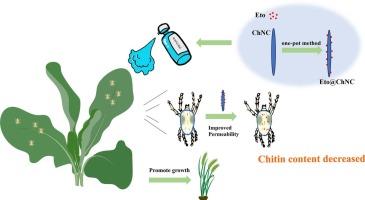利用乙螨唑负载甲壳素纳米晶体增强螨虫控制和农业安全性:合成、表征和生态影响
IF 4.2
1区 农林科学
Q2 BIOCHEMISTRY & MOLECULAR BIOLOGY
引用次数: 0
摘要
甲壳素纳米晶体(ChNCs)以其高纵横比、表面电荷和流动性而闻名,是一种很有前景的生物基纳米材料,可用于药物输送。然而,它们作为农业杀虫剂载体的潜力仍未得到充分开发。乙螨唑是一种草酸二苯酯杀螨剂,能有效抑制螨虫的卵孵化和正常蜕皮过程,但在田间应用中降解快、持效期短。本研究介绍了一种新型制剂 Eto@ChNC,它是通过一锅法将 TEMPO 氧化 ChNC 与乙螨唑复配制备而成。与传统制剂相比,Eto@ChNC 在防治荨麻蠹蛾方面的速效性和长效性显著增强。该制剂对螨卵和螨虫的增效作用分别提高了 41.74% 和 67.85%,药效延长了两天。性能提高的原因是 Eto@ChNC 在叶片表面的润湿能力增强,对 T. urticae 表皮几丁质含量的抑制作用更强,从而促进了乙螨唑的渗透。转录组测序发现了许多与几丁质代谢有关的差异表达基因,从而阐明了提高药效的分子机制。安全评估证实,Eto@ChNC 不会增加对蚯蚓或捕食性螨虫的毒性,并能促进小麦和豇豆的生长,从而强调了其环境安全性。这些研究结果表明,Eto@ChNC 是生物基杀螨剂配方的一大进步,在螨虫管理方面具有广阔的应用前景。本文章由计算机程序翻译,如有差异,请以英文原文为准。

Enhanced mite control and agricultural safety with etoxazole-loaded chitin nanocrystals: Synthesis, characterization, and ecological impacts
Chitin nanocrystals (ChNCs), known for their high aspect ratio, surface charge, and mobility, are promising bio-based nanomaterials for drug delivery. However, their potential as pesticide carriers in agriculture remains underexplored. Etoxazole, a diphenyl oxalate acaricide, effectively inhibits egg hatching and the normal molting process in mites but suffers from rapid degradation and short persistence in field applications. This study introduces a novel formulation, Eto@ChNC, prepared by complexing TEMPO-oxidized ChNCs with etoxazole via a one-pot method. Eto@ChNC was evaluated for controlling Tetranychus urticae, demonstrating significantly enhanced rapid action and prolonged efficacy compared to traditional formulations. The formulation increased the synergistic effects on mite eggs and deutonymphs by 41.74 % and 67.85 %, respectively, extending effectiveness by two days. The improved performance was attributed to the enhanced wetting ability of Eto@ChNC on leaf surfaces and its superior inhibition of the epidermal chitin content in T. urticae, facilitating greater etoxazole penetration. Transcriptome sequencing revealed numerous differentially expressed genes related to chitin metabolism, elucidating the molecular mechanisms underlying the increased efficacy. Safety assessments confirmed that Eto@ChNC did not elevate toxicity to earthworms or predatory mites and promoted the growth of wheat and cowpea, underscoring its environmental safety. These findings highlight Eto@ChNC as a significant advancement in bio-based acaricide formulations, offering promising applications in mite management.
求助全文
通过发布文献求助,成功后即可免费获取论文全文。
去求助
来源期刊
CiteScore
7.00
自引率
8.50%
发文量
238
审稿时长
4.2 months
期刊介绍:
Pesticide Biochemistry and Physiology publishes original scientific articles pertaining to the mode of action of plant protection agents such as insecticides, fungicides, herbicides, and similar compounds, including nonlethal pest control agents, biosynthesis of pheromones, hormones, and plant resistance agents. Manuscripts may include a biochemical, physiological, or molecular study for an understanding of comparative toxicology or selective toxicity of both target and nontarget organisms. Particular interest will be given to studies on the molecular biology of pest control, toxicology, and pesticide resistance.
Research Areas Emphasized Include the Biochemistry and Physiology of:
• Comparative toxicity
• Mode of action
• Pathophysiology
• Plant growth regulators
• Resistance
• Other effects of pesticides on both parasites and hosts.

 求助内容:
求助内容: 应助结果提醒方式:
应助结果提醒方式:


